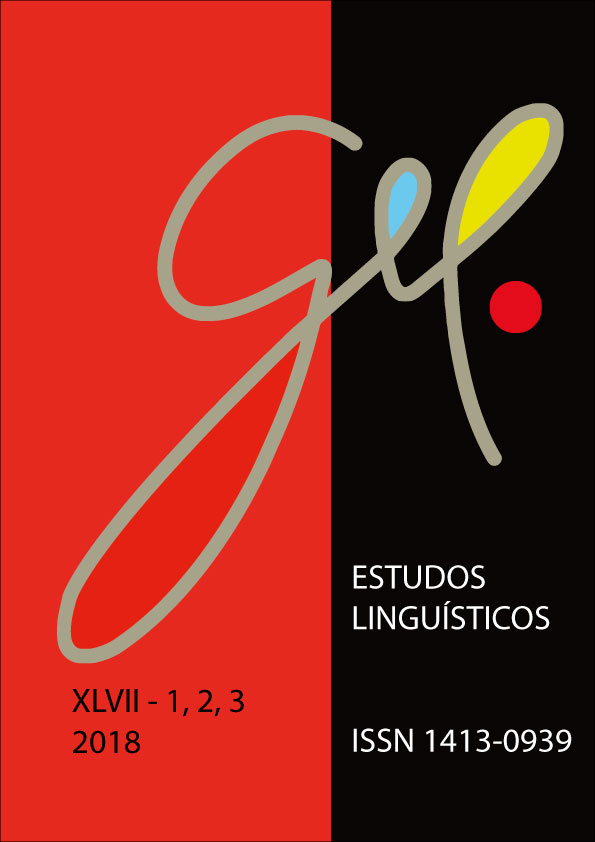Aspectos morfológicos dos verbos na língua Mehináku (Arawak)
DOI:
https://doi.org/10.21165/el.v47i1.1924Palavras-chave:
língua Mehináku, verbos, morfologia verbalResumo
O objetivo principal deste trabalho é apresentar uma análise inicial da morfologia dos verbos na língua Mehináku (Arawak). Os verbos, nesta língua, dividem-se transitivamente em dois tipos: (i) verbos transitivos, que requerem dois argumentos obrigatórios (um agente/sujeito como argumento externo e um objeto como argumento interno) e (ii) verbos intransitivos, que admitem apenas um argumento (um agente/sujeito como argumento externo). Do ponto de vista morfológico, os verbos são acompanhados por prefixos pronominais, que geralmente representam o argumento externo da construção, além de sufixos marcadores de tempo e aspecto. Os argumentos internos não são marcados no verbo, mas expressos sintaticamente.Downloads
Referências
AIKHENVALD, A. Y. The Arawak language family. In: DIXON, R. M. W.; AIKHENVALD, A. Y. (Eds.). The Amazonian languages. Cambridge: Cambridge University Press, 1999.
AIKHENVALD, A. Y. Areal diffusion, genetic inheritance, and problems of subgrouping: a north arawak case study. In: AIKHENVALD, A. Y.; DIXON, R. M. W. (Eds.). Areal diffusion and genetic inheritance. Oxford: Oxford University Press, 2001. p. 167-194.
AWETÍ, M. M. Uma descrição preliminar das classes de palavras da língua Mehináku, com foco especial na classe dos nomes. 2014. 184 f. Dissertação (Mestrado em Linguística) – Universidade de Brasília, Brasília, 2014.
COMRIE, B. Aspect. Cambridge Textbooks in Linguistics. Cambridge: Cambridge University Press, 1976.
COMRIE, B. Language Universals and Linguistic Typology. Oxford: Basil Blackwell, 1985a.
COMRIE, B. Tense. Cambridge: Cambridge University Press, 1985b.
COMRIE, B.; SMITH, G. Questionnaire. Lingua Descriptive Studies, 1977.
CORBERA MORI, A. Relações entre grafemas e segmentos nos vocabulários Waurá e Mehináku de Steinen (1866[1940]). Revista de Estudos da Linguagem, UESB, Salvador, n. 3, p. 143-157, 2006.
CORBERA MORI, A. Correspondencias entre grafemas y segmentos en los vocabularios Waurá e Mehináku de Steinen (1866[1940]). Baciyelmo (Letras. Imágenes. Creación), v. 2, p. 78-96, 2008a.
CORBERA MORI, A. Aspectos da fonologia Segmental do Mehináku. Estudos linguísticos, São Paulo, v. 37, n. 1, p. 63-72, 2008b.
FRANCHETTO, B. Línguas e história no Alto Xingu. In: FRANCHETTO, B.; HECKENBERGER, M. (Orgs.). Os povos do Alto Xingu. História e Cultura. Rio de Janeiro: UFRJ, 2001. p. 111-156.
GREGOR, T. Mehináku: O Drama da vida diária em uma aldeia do alto Xingu. São Paulo: Editora Nacional (Brasiliana), 1982.
INSTITUTO SOCIOAMBIENTAL (ISA). Povos indígenas no Brasil: 2001-2005. São Paulo: Instituto Socioambiental, 2006.
INTERNATIONAL PHONETIC ASSOCIATION (IPA). Handbook of the International Phonetic Association. Cambridge: Cambridge University Press, 1999.
LYONS, J. Semantics. Cambridge: University Press, 1977.
MEHINAKO, M. Imiyehünaku Iyayakatakú (Livro na língua materna do povo Mehinaku). Cáceres: Editora da UNEMAT, 2013.
MENEZES, M. L. P. Parque Indígena do Xingu. Campinas: Editora da UNICAMP, 1999.
RODRIGUES, A. D. Línguas brasileiras. Para o conhecimento das línguas indígenas. São Paulo: Loyola, 1986.
SCHACHTER, P.; SHOPEN, T. Parts-of-Speech systems. In: SCHACHTER, P.; SHOPEN, T. Language Typology and Syntactic Description: Clause Structure. Second Edition, v.1. Cambridge: Cambridge University Press, 1985.
SILVA, T. C. de S. Estudo preliminar da fonologia da língua Mehináku. 1990. 49 f. Dissertação (Mestrado em Linguística) – Departamento de Linguística, Línguas Clássicas e Vernácula, Universidade de Brasília, Brasília, 1990.
STEINEN, K. von den. Entre os aborígenes do Brasil central. Tradução de Egon Schaden. São Paulo: Departamento de Cultura, 1940[1894].
TRASK, R. L. Dicionário de Linguagem e Linguística. São Paulo: Contexto, 2006.
WISE, M. R. Grammatical characteristics of preandine arawakan languages of Peru. In: DERBYSHIRE, D. C.; PULLUM, G. K. (Eds.). Handbook of Amazonian Languages. v. 1. Berlin: Mouton de Gruyter, 1986. p. 567-642.



